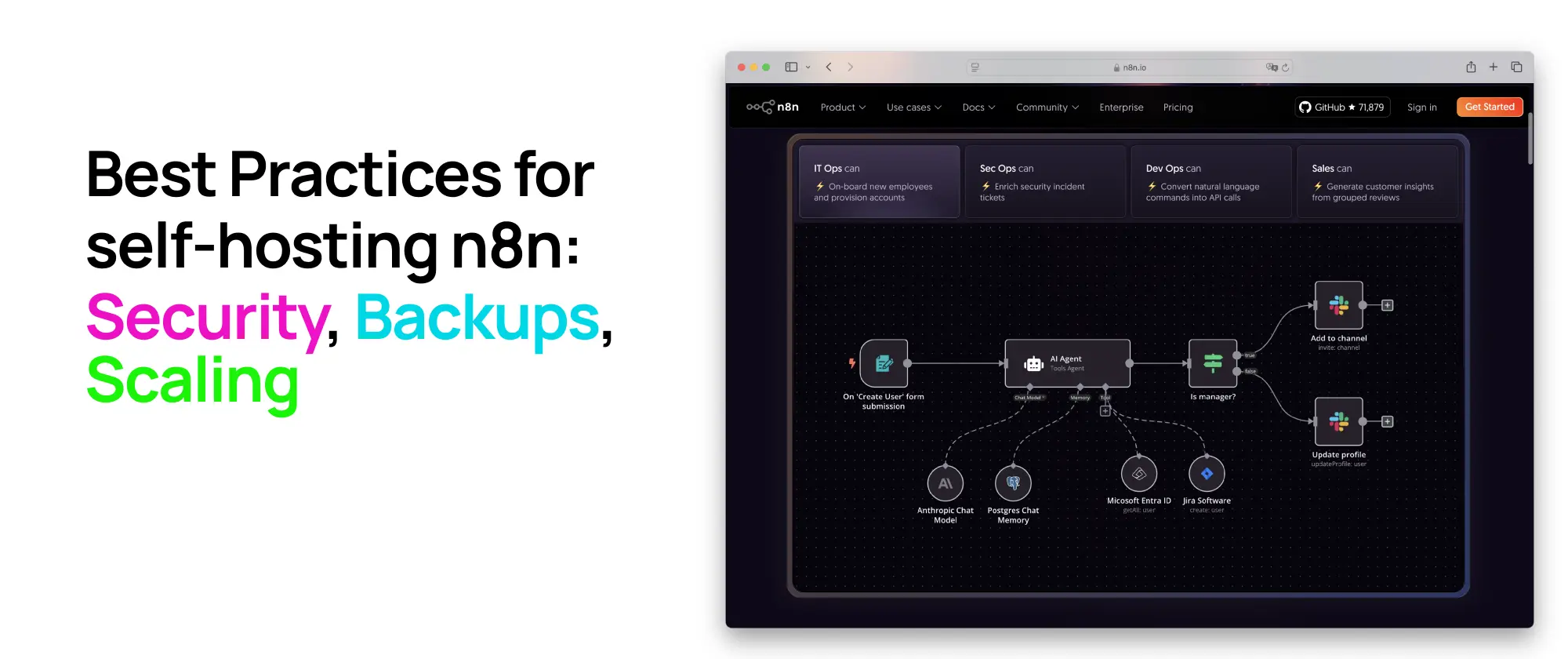
Best Practices for Running n8n on Your Own Server (Security, Backups, and Scaling)
 Jonas Scholz
Jonas ScholzRunning n8n on your own server gives you direct control over your data, integrations, and automations. Hosting n8n yourself also means you handle security, backups, updates, and scaling directly.
This guide covers the basics in each area. You will learn practical methods to make sure your n8n workflows are secure, backed up, and able to handle more load!
Security Essentials
When you self-host n8n, security becomes your responsibility. Follow these key measures to protect your server. Also, security is never done. You should always be looking for ways to improve your security!

Set Up a Firewall
A firewall monitors your traffic, allowing connections that you approve and blocking unknown requests. For Linux servers, ufw (Uncomplicated Firewall) is simple to manage.
Activate and set up ufw with these basic commands:
sudo ufw allow ssh
sudo ufw allow http
sudo ufw allow https
sudo ufw enable
This allows SSH connections (port 22) and standard web traffic (ports 80 and 443). Ports for n8n itself depend on your setup, so make sure you open any additional ports if needed. This might not work if you are using Docker, and generally it is a good idea to use multiple firewalls at different levels!
Keep Your Server Updated
Regular updates help prevent security problems. Schedule updates regularly. On Ubuntu/Debian systems, automatic updates are easy to set up:
sudo apt install unattended-upgrades
sudo dpkg-reconfigure --priority=low unattended-upgrades
This ensures critical updates are installed regularly, keeping your server secure.
Use Fail2ban for Brute-Force Protection
Brute-force attacks repeatedly attempt login credentials. Fail2ban helps by automatically blocking suspicious IP addresses. Install fail2ban on Ubuntu/Debian easily:
sudo apt install fail2ban
sudo systemctl enable fail2ban
sudo systemctl start fail2ban
Fail2ban watches common services by default, including ssh. Additional custom rules can be added easily in /etc/fail2ban/jail.local.
Set Up a Reverse Proxy (Caddy recommended)
Caddy is a modern web server that automatically handles HTTPS certificates and provides a simpler configuration syntax. Here's how to set it up:
# Install Caddy (Ubuntu/Debian)
sudo apt install -y debian-keyring debian-archive-keyring apt-transport-https
curl -1sLf 'https://dl.cloudsmith.io/public/caddy/stable/gpg.key' | sudo gpg --dearmor -o /usr/share/keyrings/caddy-stable-archive-keyring.gpg
curl -1sLf 'https://dl.cloudsmith.io/public/caddy/stable/debian.deb.txt' | sudo tee /etc/apt/sources.list.d/caddy-stable.list
sudo apt update
sudo apt install caddy
Create a Caddyfile at /etc/caddy/Caddyfile:
yourdomain.com {
reverse_proxy localhost:5678
}
This simple configuration will:
- Automatically obtain and renew SSL certificates
- Handle HTTPS redirection
- Proxy requests to your n8n instance
Start and enable Caddy:
sudo systemctl enable caddy
sudo systemctl start caddy
Caddy will automatically handle SSL certificates and HTTPS setup, making it much simpler than traditional web servers.
Reliable Backup Strategies
Obviously, your workflows and data should be backed up frequently. Who likes losing data?
Back Up Data Volumes
If you're using Docker, your workflows and configuration are stored in volumes or folders. Create a regular backup schedule. For example, docker volumes backup:
docker run --rm \
-v n8n_data:/source \
-v $(pwd)/backups:/backup ubuntu \
tar cvf /backup/n8n-backup-$(date +"%Y-%m-%d").tar /source
Adjust paths as necessary.
Store Backups in Different Locations
Never store backups only on your server. Copy the backup files to external sources, like AWS S3 or DigitalOcean Spaces, using tools like rclone.
Example backup upload with rclone:
rclone copy /path/to/your/n8n-backup-2025-04-10.tar remote:my-backups/n8n/
Make sure rclone is properly set up for your chosen cloud provider.
Perform Test Restores Often
Backup files need regular restoration tests. Periodically try restoring from backups in a safe environment to confirm everything works. This prevents surprises during an incident.
Effective Scaling
Your n8n workflows might require more resources over time. These are common ways to scale performance effectively.
Monitor Server Resources
Keep an eye on CPU, RAM, disk usage, and network load. Use basic Linux tools like htop, free -m, and df -h.
Upgrade Your Server Resources
When your workflows become demanding, increase CPU, memory, or storage. Providers usually allow you easy upgrades.
Advanced Scaling Options
If performance requires multiple n8n instances behind a load balancer (like Nginx or cloud provider load balancing options), ensure you configure shared storage (or database) properly. This preserves workflows consistency across multiple instances.
Simple Solution: sliplane.io Hosting
If the tasks to maintain security, backups, and performance seem complicated, a simpler managed hosting option is sliplane.io.
Sliplane offers managed Docker hosting specialized for running n8n. Key benefits include:
- Automatic firewall protection and Fail2ban setup.
- Built-in SSL with automated certificate management.
- Automatic backups to safe off-site locations.
- Effortless and effective server scaling directly from your dashboard.
- Fast updates to your n8n instances with minimal downtime.
Sliplane can deploy n8n with just one-click, providing an ideal environment optimized and secure from the start.
Consider using sliplane.io to simplify your operations and focus on automating your workflows instead of maintaining server infrastructure.
Cheers,
Jonas, Co-Founder of sliplane.io